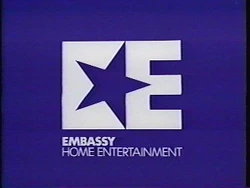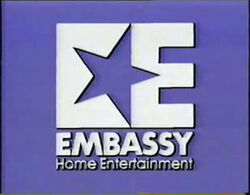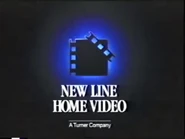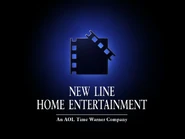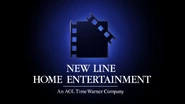Background: The unit was initially established in 1981 as "Andre Blay Corporation" by the titular former head honcho of Magnetic Video Corporation. By then, the company released videocassettes (VHS and Betamax) and laserdiscs under the "Blay Video" name. In early 1982, Embassy Communications, Inc. acquired the company, and it was renamed to "Embassy Home Entertainment". In 1985, EHE established the Charter Entertainment label for genre films. Embassy Home Entertainment was purchased by Nelson Holdings International from Coca-Cola in 1986 for $85 million and it was combined with Galactic Films (which Nelson acquired in 1985) to become "Nelson Entertainment". Nelson started releasing its videos in 1988 through Orion Home Video until 1991, when New Line Cinema acquired Nelson's video assets in May 1991, and after that it was transferred from Orion to RCA/Columbia Pictures Home Video, which became Columbia TriStar Home Video (now "Sony Pictures Home Entertainment") took over distribution until when after Turner acquired NLC on January 28, 1994, when Turner Home Entertainment took over distribution. Laserdisc releases were distributed by Image Entertainment. Until 1994, it distributed some Castle Rock Entertainment films and reissued several former titles from predecessors in addition to the main studio's selections. In 2008, it was made a division of Warner Home Video, and was folded into the latter two years later. The Blay, Embassy and Nelson days catalog titles was sold to Crédit Lyonnais Bank, to be incorporated into the Alpha library of Epic Productions, and later to PolyGram Filmed Entertainment. As for Nelson Holdings International, it was renamed to "JPY Holdings" in 1994. In 1998, Seagram and Sons acquired PolyGram Filmed Entertainment and in January 1999, Metro-Goldwyn-Mayer acquired the pre-March 31, 1996 PolyGram library (including all of PolyGram's back library) from Universal Studios for $250 million and the library was merged into the library of MGM's then-recently acquired Orion Pictures unit (as mentioned above, Orion released select films produced by Nelson). Currently, most of the films from the Nelson Entertainment days are owned by MGM, although television rights to some films are owned by Paramount Pictures due to a previous deal Nelson made with Viacom. North American broadcast rights are currently held by Trifecta Entertainment & Media under license from Paramount.
Blay Video[]
(1981-1982)[]
Logo: A neon orange circle surrounded by white glitter zooms out on a black background. After it zooms out, two red/orange/white gradient comets fly by the circle all at once, with one on the top edge and one on the bottom edge. We suddenly cut to the circle that now has a curved rectangle on top of it that says "Blay VIDEO" on it. The object then flashes, and becomes a bronze pendant. Glowing an orange aura, it shines from left to right.
FX/SFX: Decent early 1980s effects, though after the comets streak through the circle, it jarringly cuts to the glowing orange version of the finished product.
Music/Sounds: A synthesized orchestra-like fanfare.
Availability: Extremely rare, as the company barely lasted a year, a very short life span. It can be found on its releases, which are hard to find. The image seen here was captured from a 1982 VHS release of Revenge (also known as Inn of the Frightened People). Some releases may have the 1982 Embassy Home Entertainment logo at the beginning.
Embassy Home Entertainment[]
1st Logo (Mid-1982-83)[]
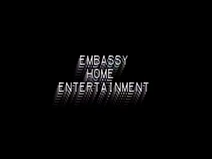
Logo: On a black background, we see:
HOME
ENTERTAINMENT
with a white shadow effect behind it.
FX/SFX/Music/Sounds: None.
Availability: Rare. Can be seen at the beginning of the Raccoons on Ice/The Christmas Raccoons video along with the very first VHS releases of Summer Lovers, Humongous, An Eye for An Eye, Swamp Thing, Escape from New York, and Zapped. The logo can also be retained on reprints of Embassy's 1982-83 video catalog (including a 1983 VHS reissue of The Soldier, after the next logo).
2nd Logo[]
(December 1982-87)
Nicknames: "Rotating ☆E" (USA), "Still (Rotating) ☆E" (International)
Logo: Same as the Embassy Television logo, but the text reads
EMBASSY
HOME ENTERTAINMENT
instead.
Trivia: This logo was designed by Chermayeff & Geismar Associates of New York.
Variants:
- From 1984-1987, after the logo animates the "®" symbol fades in at the bottom-right corner next to the text. The logo also originally appears to be filmed, and cuts in and out; the "®" version fades in and out smoothly and is videotaped.
- A still version of this was used for international videocassettes starting in 1985. The logo appears to have a lighter (or darker) blue background, the words "EMBASSY" are in a much larger font, and "Home Entertainment" is written below in a Helvetica font. This variant was so far only seen at the end of European (Like the UK pre-cert release of The Howling) and Australian releases (the next logo below would be at the beginning on Aussie tapes).
- At the beginning of some European tapes, such as Saving Grace, this variant is used, but with outlines around the logo and text. "Home Entertainment" is also in a different font.
FX/SFX: Same as the television logo. The international version is still.
Music/Sounds: Same as the Embassy Television logo, but the fifth note is in a higher note than usual and after the sixth note in the theme, we instead hear a 10-note synth-flute section. This was composed by Ray Colcord, who also composed the main Embassy Television logo.
Music/Sounds Variants:
- On the international version, it is silent.
- At the end of the UK pre-cret of The Racoons & the Lost Star, the end theme of the program is heard.
- On German tapes, a jazzy Eighties-like synth tune is played.
Availability: Rare. It can be found on various Nelson and Embassy Home Entertainment releases like The Emerald Forest and The Graduate. Could be in worldwide releases. Surprisingly, this logo appeared on TV airings of A Chorus Line (the MGM DVD & Blu-ray releases show its print logo on the back cover, but not on the releases themselves) and TCM airings of Bittersweet Love. It's also surprisingly preserved on the Nelson VHS reissue of The Red Balloon, despite Embassy being mentioned nowhere on the packaging. The still version appears on the UK pre-cert release of The Howling. It also appeared on an old Showtime/The Movie Channel broadcast of Kiss of the Spider Woman. The logo was retained on the 1992 New Line Home Video reissue of Blade Runner and the 1998 MGM VHS reissue of Sid and Nancy.
3rd Logo[]
(international only) (1983-1987)
Logo: A sky blue background eases out revealing a large "E" like the previous three logos. As in zooms out, a white, tilted star zooms into the big space of the "E". When it runs out of room, the animation stops for a full second, showing the Embassy logo just like since 1982. Next, the "E" zooms in and the star zooms out, basically the beginning in reverse. Then the following fades in:
Home Entertainment
Finally, when the text fades out, "Presents" fades in.
FX/SFX: The zooming of the "E" and the star.
Music/Sounds: None.
Availability: Extremely rare. Probably another international logo, considering it was on a Spanish language tape.
4th Logo[]
(international only) (1983-86)

Nicknames: "Neon ☆E Sign", "The Big E in Video", "Flashing ☆E"
Logo: On a black background, a yellow, neon outline version of the Embassy logo zooms out. Flashes then add color to the logo, making the "E" dark blue and the star dark red. "THE BIG" and "IN VIDEO" zooms out and flashes one-by-one, above and below the logo respectively. The logo then shines over. Then, it zooms out with the dusty trail effect.
FX/SFX: The zooming and flashing.
Music/Sounds: A four-note synthesizer tune, followed by two drumbeats, and then another set of five synth notes.
Availability: Extremely rare. You may want to hit up used video stores in Australia for this one, as it only appeared at the front of Publishing & Broadcasting Video (PBV) tapes released in the timeframe.
5th Logo[]
(1986-1988)
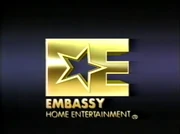
Nicknames: "Golden ☆E", "CGI ☆E"
Logo: A three-dimensional, gold version of the starred "E" logo comes in from the left of the screen turned diagonally. As it turns face forward, a similarly colored star outline floats as if coming down an invisible slope and comes through the star-shaped hole in the "E" and becomes its border. Below the "E" appear, also in gold, the words:
EMBASSY
HOME ENTERTAINMENT
with "EMBASSY" fading in and "HOME ENTERTAINMENT" simply appears with the (R) symbol at the bottom-right.
Variant: The logo where the "E" is far out plays and dissolves over the 1982 logo; then a star trailing CGI dust showing the Nelson logo within spins around until it's in the center; then it fades into the Nelson logo and it proceeds from there.
FX/SFX: The moving "E", the words coming in sync with the music.
Music/Sounds: A fast paced, dramatic synth tune. The variant has the looped version of the first half of the triumphant fanfare version of the Nelson Entertainment logo.
Availability: Rare. Seen on video releases of The Producers, Defense of the Realm, The Stepfather, The Video Dead, and River's Edge. Oddly, the 1998 MGM VHS reissue of Eddie and the Cruisers retains the logo at the end (due to an older video master being used for the feature itself).
Nelson Entertainment[]
(August 19, 1987-October 11, 1991)[]
Nickname: "Nelson's Column"
Logo: On a black background, we see a monument inside a rectangle, all in white shadows. Slowly, everything turns in color; the background turns blue, the monument becomes a greenish-white, and the background in the rectangle turns into a time-lapse video of clouds moving. "NELSON" appears on top and "ENTERTAINMENT" appears on the bottom, both in gold, and they shine.
Trivia: The monument is "Nelson's Column", located at Trafalgar Square in central London to commemorate the death of Admiral Nelson at the 1805 Battle of Trafalgar.
Variants:
- The 1990 version of Hamlet does not contain this logo. At the end credits, it features the company's print logo, where the word "FILMS" is used in the place of "ENTERTAINMENT".
- Texasville has a shortened version of this logo, fading in right before the company name fades in.
FX/SFX: Just very good animation.
Music/Sounds: On some early video releases, a series of rising synthesized tremolo violin notes; during the last two, some fast synth-drums appear. Another earlier variant used a different, more triumphant synth fanfare ending with some chimes. In most other cases, it used the opening theme of the film or was silent.
Availability: Uncommon. It can be found on some films and home media releases by the company between 1987 to 1991, but not all of them. The most common release with this logo was the 1988 American VHS release of The Princess Bride (plastering the 1981 20th Century Fox logo at the beginning and later appearing at the end), the 1991 New Line Home Video (distributed by RCA/Columbia Pictures Home Video) VHS release of Misery, and some older foreign releases of City Slickers. Also seen on Bill & Ted's Excellent Adventure (including a September 2009 Trifecta Entertainment airing after the 2003 Paramount Pictures and 1982 Orion Pictures logos), Winter People, Eve of Destruction, Prancer, and The Taking of Beverly Hills. Some old TV prints of The Sure Thing feature this logo at the beginning and end of the film. This logo is not on Bill & Ted's Bogus Journey, The Favor, There Goes My Baby (the latter two films were released in 1994 due to Orion's bankruptcy) and recent prints of Castle Rock Entertainment films that Nelson co-produced. On reprints of Embassy Films Associates catalog titles such as Hans Christian Andersen, the original Embassy Home Entertainment logo will be used instead. This was also present on a ThisTV broadcast of Cohen and Tate, preceded by the 2001 MGM logo. The logo first appeared on the 1987 VHS, Betamax and Laserdisc releases of The Whistle Blower and On the Line, as well as various international releases. The triumphant fanfare version can be heard on some earlier Nelson videos from 1987-88, including the Japanese Laserdisc of The Name of the Rose.
New Line Home Entertainment[]
1st Logo (1991-July 4, 1995)[]
Nicknames: "The Filmbox", "Box and Filmstrips", "The Ladder", "New Line Filmbox"
Logo: Same as the 1987 movie logo, butNEW LINE HOME VIDEO fades in under the ladder.
Variants:
- On RCA/Columbia, Columbia TriStar, and 1994-95 Turner releases, a still version appears at the very start of the tape, where the box and filmstrips look slightly different.
- Normally, this fades in and out, but on the 1994 screener VHS of Three of Hearts, it cuts in and out.
- There is a widescreen version of this logo's seen on such releases, like the 1994 laserdiscs reissues of When Harry Met Sally, City Slickers and Escape from New York.
- An Amos and Andrew home video spot shows this next to the 1993 Columbia TriStar Home Video logo on a black background.
FX/SFX: Same as the 1987 movie logo.
Music/Sounds: None.
Music/Sounds Variants:
- On some releases, like Late for Dinner (plastering the film's Columbia Pictures logo) and National Lampoon's Loaded Weapon 1, the opening theme starts over it.
- On the screener VHS (the actual release uses the next logo) of Mortal Kombat: The Journey Begins, as well as the UK release, the first part of The Immortals' "Mortal Kombat" (from the soundtrack of the 1995 film) plays over it.
Availability: Scarce. It's seen on New Line/Castle Rock releases by Columbia TriStar/Turner Home Entertainment on VHS and Image Entertainment on Laserdisc. Titles with this logo include City Slickers, Freddy's Dead: The Final Nightmare, Mr. Saturday Night, Above the Rim, and North. This was used on a few titles distributed by Turner Home Entertainment such as The Mask, Dumb and Dumber (only some prints; later printings use the next logo), Corrina Corrina, 8 Seconds, Wes Craven's New Nightmare, and Death and the Maiden (the final release to have it). This can also be spotted on Comedy Central's print of Honeymoon in Vegas, Starz/Encore's print of Year of the Comet and TNT's print of Death Ring. Strangely, the 2000 MGM VHS reissue (but not its DVD) of Honeymoon in Vegas retains it.
2nd Logo (July 25, 1995-February 9, 2010; March 29, 2011)[]
Nicknames: "The CGI Filmbox", "The Filmbox II", "Box and Filmstrips II", "The CGI Ladder", "The Ladder II", "New Line Filmbox II"
Logo: Same as the 1994 movie logo, but "NEW LINE HOME VIDEO" (or "ENTERTAINMENT") zooms out from below. The respective company byline fades in underneath. It's also videotaped.
Bylines:
- 1995-1997: "A Turner Company"
- 1997-2001, November 2003-2010: "A Time Warner Company"
- 2001-December 2003: "An AOL Time Warner Company"
- 2004-2008: "A TimeWarner Company"
- Sometimes, this logo is bylineless.
Variants:
- On VHS tapes and demo DVDs, there is a still of this logo seen before the warning screen. This version also appears at the end of one featurette each on the 2003-06 DVDs of How to Deal and The Man.
- On the 1993 demo VHS of 12:01, this cuts in and out rather than fading.
- On some VHS releases, about halfway through the animation, streaks of green appear through the blue glow. This can be found on the 1998-99 releases of The Wedding Singer, Pleasantville, and A Nightmare on Elm Street. However, the DVDs of all three (plus a Warner Bros. Century Collection VHS reissue of Pleasantville) use the standard variant.
- On DVDs, the full screen version plays the logo at a rate of 30fps during most of the animation, and the text zooms out at twice that. The widescreen versions of the AOL Time Warner and the 2004 TimeWarner byline variants are rendered in 24fps. The widescreen versions of the 1995 Turner, 1997 and 2003 Time Warner variants are rendered in 30/60fps. A widescreen Turner variant was used on a few early 1997 DVDs in anamorphic widescreen, such as The Long Kiss Goodnight, Dumb and Dumber, and Jackie Chan's First Strike. DVDs in "letterboxed" widescreen, such as The Mask and Mortal Kombat, use the regular full screen version.
- On some releases, the Time Warner byline is in bold and in all caps. This has been spotted on the original DVD prints of Gummo, 8 Seconds, Boogie Nights, Magnolia, Lost Souls, Austin Powers: The Spy Who Shagged Me, Corinna Corinna, Detroit Rock City, Boiler Room, Feeling Minnesota, Final Destination, Now and Then, and the individual DVD releases of the A Nightmare on Elm Street series (the original was released in 1999, while the sequels were released in 2000).
- There is one 4:3 version of the AOL Time Warner byline variant that has similar camera field of vision angle degrees as the 60p version of the logo. Another notable difference is that the byline is not near the bottom of the screen. This was spotted on the 2001 VHS reissue of Mortal Kombat.
- A 4:3 anamorphically squished version of the widescreen AOL Time Warner variant appears on the full screen side of a 2003 DVD reissue of Dumb and Dumber.
- There are 4:3 cropped variants of the widescreen AOL Time Warner and 2003/2004 TimeWarner variants. The first two can only be viewed in 4:3 mode on all DVD players, while the 2004 variant can be found on all 2004-06 VHS releases.
- On the 2002 DVD of Brother's Keeper, the 16:9 variant is squished into 4:3.
- At the end of "Making Rush Hour 3," an in-credit variant is used.
FX/SFX: Same as the 1994 movie logo.
Music/Sounds: Same as the 1994 movie logo, though sometimes it can be silent, such as on the Platinum Series releases of Boogie Nights and Se7en.
Music/Sounds Variants:
- On Mortal Kombat: The Journey Begins, it has part of the "Mortal Kombat" song by The Immortals.
- At the end of "'How to Deal' with Y.A. Literature," the closing theme of the program continues over the logo.
Availability: Uncommon. Used from New Line's purchase by Turner Broadcasting to 2010, when New Line Home Entertainment was folded into Warner Home Video.
- The Turner variant was used from 1995-97, starting with In the Mouth of Madness, and also appears on some early DVDs such as Friday, The Adventures of Pinocchio, The Mask, Dumb and Dumber, Mortal Kombat, Teenage Mutant Ninja Turtles (1990), and The Long Kiss Goodnight.
- The 1997 Time Warner variant was used until 2001. Titles with this version include Spawn, Rush Hour, Pleasantville, The Wedding Singer, Blade, Boogie Nights, Lost in Space (1998), the first two Austin Powers movies, and the Nightmare on Elm Street Platinum Series DVD box set. Some of the last releases to use the "HOME VIDEO" variant were The Little Vampire and Little Nicky.
- The bold caps variant of the Time Warner byline can be found on the titles mentioned above.
- The "HOME ENTERTAINMENT" variant replaces the "HOME VIDEO" variant on several reprints of pre-2001 DVDs such as The Corruptor, Boiler Room, Rush Hour, Austin Powers: International Man of Mystery, Mortal Kombat, The Mask, Final Destination, Blade, Teenage Mutant Ninja Turtles, the A Nightmare on Elm Street box set, and Pump Up the Volume (however, the disc labels and cases still use the New Line Home Video logo along with a 1999 copyright date).
- The AOL Time Warner variant can be found on several 2001-03 VHS and DVD releases such as Sugar & Spice, 15 Minutes, Rush Hour 2, Austin Powers In Goldmember, Blade II, Willard (2003), How to Deal, and the Lord of the Rings trilogy.
- The 2003 Time Warner variant can be found on the VHS releases of Freddy vs. Jason and Secondhand Lions, and some DVDs such as How to Eat Fried Worms and the 2005 reissue of The Mask.
- The 2004 TimeWarner variant can be found on the 2004 VHS releases of ELF and Blade: Trinity, and most 2005-2010 DVDs such as Hairspray (2007), Blade: House of Chthon, Running Scared, and the unrated cut of Dumb and Dumber.
- Some of the last VHS tapes to use this logo were Raise Your Voice, After the Sunset, Son of the Mask, Harold and Kumar Go to White Castle, The Man, Wedding Crashers, and A History of Violence (one of the last major Hollywood films to ever earn a retail release on the format). Some of the last overall releases to use this logo include The Time Traveler's Wife and The Final Destination. Surprisingly, it returned on the first disc of the 2011 DVD set Friday 3-Movie Collection, consisting of Friday: The Director's Cut and Next Friday.
- Strangely, this does not appear on the DVD of Dungeons & Dragons, or any Infinifilm releases (which instead use a special logo).
Editor's Note: Same as the 1994 movie logo.
New Line High Definition[]
(November 20, 2007-February 9, 2010)[]
Nicknames: "The Filmbox III", "Box and Filmstrips III", "The Ladder III", "HD Filmbox", "HD Ladder", "HD Box and Filmstrips", "New Line Filmbox III", "New Line HD Filmbox"
Logo: We see the New Line logo forming as usual, but the details are quality improved, and the background light consists of many rays. The words are in Bank Gothic MD BT font, appears more silver and 3D. When the logo is formed, a very bright light flash occurs, making the words change to "HIGH DEFINITION".
FX/SFX: Same as the theatrical and home entertainment logos and using all capacities of the Blu-ray discs.
Music/Sounds: An extended version of the New Line fanfare, accompanied by a light flash sound.
Availability: Common. Can be seen on all New Line Home Entertainment Blu-ray releases until 2010.



